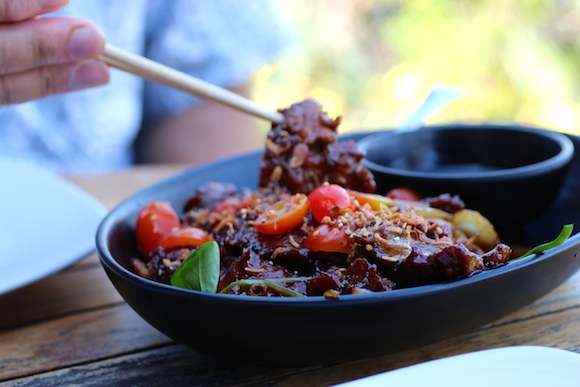Understanding UMAMI
“Those who pay careful attention to their taste buds will discover in the complex flavor
of asparagus, tomatoes, cheese and meat, a common and yet absolutely singular taste
which cannot be called sweet, or sour, or salty, or bitter…” – Dr. Kikunae Ikeda
Eighth International Congress of Applied Chemistry, Washington D.C., 1912
You recognize it in the meaty taste of a sizzling rib-eye steak hot off the grill. Beyond salty, you sense it in the savory tastes of aged Parmesan and cured anchovies on a Caesar salad. Beyond sweet, your mouth waters over the flavor of a warm ripe heirloom tomato picked right off the vine.
Can you taste it yet? In addition to sweet, sour, salty and bitter…it’s umami, the fifth taste sensed by the human tongue.
Umami is defined as the savory taste and round mouth-feel imparted by glutamate and nucleotides such as inosinate and guanylate.
Over a century after its discovery, there is a huge fascination with this fifth taste because understanding the science behind umami can help cooks create more luscious dishes and help foodies better appreciate their meal.
In 1908, a chemistry professor at Tokyo Imperial University was intrigued by the complex flavor and deliciousness of dashi, a simple Japanese soup base made from seaweed. Upon investigation, Dr. Kikunae Ikeda was able to isolate the principal flavor ingredient of kombu (the kelp used to make dashi). Using classical chemistry procedures he identified this substance as glutamic acid, with the molecular formula C5H9NO4.
Glutamic acid is a type of amino acid, which are the building blocks of proteins. Bound with minerals such as sodium, potassium, or magnesium, glutamic acid becomes glutamate, a salt. It is the salt form of glutamic acid that elicits the taste. Ikeda named that savory taste “umami,” a word from the Japanese adjective for delicious.
Following Ikeda’s glutamate discovery other foods were determined to be sources of umami. In 1913 the nucleotide inosinate was identified in bonito flakes (dried fermented skipjack tuna) and in 1960 the nucleotide guanylate was identified in dried shiitake (mushroom) stock. Nucleotides are the basic building blocks of DNA and RNA. Inosinate is found in meat and fish, while guanylate is more abundant in plant foods, particularly mushrooms. The combination of glutamate plus inosinate and/or guanylate produces a synergistic flavor effect, where the result is even more pronounced than in the individual components.
While it was first recognized in Japan, umami is a universal taste. Notice this “flavor-burst” in the various cuisines around the world. Italian lasagna, for example, is made with tomato sauce (glutamate) and meat (inosinate) and cheese (glutamate). Korean kimchi is bursting with umami where napa cabbage (glutamate) flavor is enhanced with fermented shrimp (inosinate). Even an American bacon cheeseburger is a fine example of umami synergy with beef (inosinate), cheese (glutamate), bacon (inosinate), ketchup (glutamate).
By the 1980s, studies had proven umami to be a legitimate basic taste. In the mouth “savory” taste receptors on the taste buds respond to glutamate, just like “sweet” taste receptors respond to sugar.
In addition to naturally occurring umami flavors, the processes of curing and fermentation form and release amino acid and nucleotide compounds. Asian ingredients such as kimchi, soy sauce, mirin, miso, sake and oyster sauce have exceptionally robust umami profiles.
Looking for a local restaurant in SoCal where umami is king? Head over to Terranea Resort in Rancho Palos Verdes and give Bashi a try. The Bashi menu offers a contemporary blend of Asian flavors chock-full of umami-rich ingredients such as fermented black beans, Chinese sausage, Vietnamese nuoc cham (fish sauce dressing), wakame (seaweed), shiitake and more.
Chef Bruce Nguyen is a master at letting the natural flavors define the dish.
“I believe that umami is an essential part in the flavor profile that I aim for when coming up with dishes for the menu,” Nguyen said. “While most people do not understand what umami is or even know of its existence, umami is present in everyday foods that we all enjoy.”
Try shaking beef, a popular Vietnamese dish of wok-seared thin-sliced tender beef and ripe tomatoes.
“The shaking beef is a signature dish that has been on the menu at Bashi since the restaurant opened,” Nguyen said. “Umami is highly present in this dish, from the soy sauce to the deep rich flavored oyster sauce which is enhanced with the tart lime sauce.” The hydro watercress offers a nice peppery contrast to the silky beef.
Nguyen also suggests sharing the stir fried Manila clams, another super-savory dish with Chinese bacon, green chiles, Thai basil, fermented black beans and shrimp crackers. His menu, featuring fresh local ingredients, pays homage to the Japanese farming families who first settled on the Palos Verdes Peninsula in the early 1900s.
It’s hard to beat a casual al fresco meal on the patio at Bashi, overlooking the pool and blue Pacific, especially when that meal is intensified by incredible mouth-watering umami-rich flavors.
(From my column in Random Lengths News, May 16 – 29, 2014 issue).
Bashi
100 Terranea Way, Rancho Palos Verdes, CA
(310) 265-2800
www.terranea.com






Great post about umami! And I love your examples of “umami” in dishes where we all can relate and understand. And that shaking beef looks so good!
Thank you for the lesson – I have never seen this word increasingly used these days explained so clearly!
Umami! i included an umami chapter in my Savory Cocktails book. GREG
Another lesson learned. Great post